
Andy Lloyd's Dark Star Blog

Blog 24 (March 2015)
The Implications of Mars' Chaotic Tilt
The Martian surface is a dry, barren wilderness whose surface area is similar to the landmass of Earth. Scientists have long disputed any notion that water, and life, might exist upon the Red Planet - since the days of the Viking landers, anyway. But for the last 15 years, the 'life on Mars' chill has gradually thawed in academic circles as anomalous evidence has emerged of water in Martian rocks, and even dry river beds spotted by orbital reconnaissance (1). These gullies, which are sinuous channels found on steep slopes in mid and high latitudes, are mostly located at higher altitudes where the Martian atmosphere is thinner. This will make them tricky to visit by future landers, as there is less atmosphere to support a soft parachute landing onto potentially steep slopes.
So, what we know about them we know simply from images of them taken from space. Fortunately, they are extensive enough to provide a pattern of evidence that weaves its own story about water on Mars. A scientific examination (2) of these images has been recently published which indicates that Mars probably has its own large-scale climate cycles - essentially Martian Ice Ages (which is currently the dominant feature) and interglacial periods which arise according to the planets variation in tilt, and other orbital fluctuations:
"Climate change caused by the variations in the tilt of Mars' poles may be the reason for the periodic water flows. Over time, as the pole changes tilt, sunlight hits different areas of the planet, causing the ice to migrate from the poles to more "temperate" latitudes. Right now, Mars is in a position where liquid water is unlikely to flow at gully locations. Climate models in concert with the gully observations predict, however, that water would have flowed as recently as 500,000 years ago.
"Numerous observations of Mars in recent decades have shown evidence of not only gullies, but even a potential ancient shoreline where an ocean could have been. Furthermore, NASA's Opportunity, Spirit and Curiosity rovers have all found signs of ancient water in the rocks." (3)
Looking at these images, one could be forgiven for believing that these dry river beds were more recently laid than half a million years ago. Other recent work has brought the dates closer still - a mere 200,000 years (4). In last September's blog (5), I discussed the finding by the Curiosity Rover of rounded pebbles in the crater that it was exploring - objects that insinuate the action of flowing water at some point in the Martian past:
"On Earth, roundness is a tell-tale sign that rocks have been transported a long way, since their angular edges got smoothed out as they tumbled. The Mars rocks are too big to have been blown by wind, so the team concluded it must have been flowing water. This dovetails with orbital images hinting that the rover landed in an alluvial fan, a feature that is formed on Earth by water flows." (6)
So, although most of the more dramatic gullies are in high altitude regions less accessible by landers and rovers, Curiosity has had the good fortune to provide corroborating evidence for surface water flow in a part of the Martian landscape considered to be very ancient indeed.

Gullies on Mars, ~ -71 degrees latitude in the southern hemisphere.
Imange Credit: NASA/JPL-Caltech/University of Arizona
When this story broke, I argued that these dry river beds should surely have been buried over time by the accumulation of debris and dust periodically swept around Mars by its famous dust storms (5). As it happens, the scientific team, led by James Dickson, who have been carefully examining the many images of the Martian gullies have concluded that erosion and burial do indeed play a part in the life-cycle of these geological features. Here are the main observational results of their studies:
Fate of gullies on Mars ranges from complete removal to burial.
Gullies at low latitudes are eroded and removed; gullies at high-latitude are buried.
Inverted gullies are found between 40° and 50°S, between eroded and buried gullies.
Inverted gullies require a minimum paleo-thickness of the latitude dependent mantle of ~30 m.
Buried gullies cannot be explained by present-day activity (2)
Ice, particularly CO
2 permafrost, plays an important role in the composition of surface materials in the areas where these gullies are more common. Some of the movement of dry surface material in-filling the gullies may result from the periodic sublimation of frozen CO2, destabilising rocks/dirt/pebbles making up the ground surface around these features. But that movement of dry materials is insufficient to explain gullies that exhibit 'sinuosity values' in excess of what what is measured for dry channels on Earth (7).
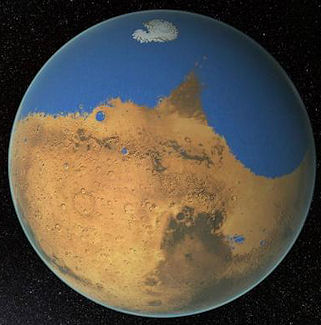
Artist’s conception of water on ancient Mars.
Image Credit: NASA’s Goddard Space Flight Center
Seemingly, the erosion and burial of the gullies is periodically off-set by a re-emergence of liquid water once again cutting its way through the ancient, half-buried valleys, as the most recent findings have demonstrated:
"However, our results suggest that melting of water ice was considerably more viable as an erosive agent during recent high-obliquity excursions, coincident with periods when ice accumulation is predicted to have occurred at gully locations." (8)
The main driver for this is the changing position of the Martian poles over long time periods, as a result of the change in the planet's tilt, or obliquity:
"Mars' "obliquity" -- the tilt of its spin axis -- is known to slowly increase and decrease between about 15 degrees and 35 degrees over a 124,000-year cycle (unlike Earth's tilt, which slowly rocks through a range of only 4 degrees thanks to the stabilizing tuggings of our large Moon). Indeed, recent studies suggest that occasionally -- at intervals of a few tens of millions of years -- Mars' obliquity may swing from 0 degrees all the way up to 60 degrees. (Thus Mars sometimes joins Uranus and Pluto as the only planets that "lie on their side"). At present -- by sheer chance -- Mars is about halfway through one of its obliquity cycles, at a tilt of about 25 degrees." (9)
This extreme shift in the position of the Martian poles could have massive climate effects on the planet as the cycle progresses. Ice caps of water and CO2 would be warmed as they shift towards the equator. The ices would then sublimate into vapour. The CO2 component thus released into the atmosphere as the planet tilts onto its side not only adds to the thickness of the Martian atmosphere, but also provides a global warming greenhouse effect, providing a virtuous circle or atmospheric thickening and warming.
The water released into the atmosphere increases humidity, and most likely accumulates as frost and ice onto the newly polarising zones. Hence, over time there would be the formation of new ice caps not seen today - caps which in term may destablise as the climate warms further and lead to rivers of melt water across the Martian landscape. Perhaps even the fleeting return of an ocean; the past existence of which has been suggested by spectrometer measurements of the distribution of various leached metals across the planet's surface (10).
The very cyclical nature of this process insinuates that Mars may have undergone these changes many, many times over its lifetime. Indeed, we are observing the planet mid-cycle - a point which is, clearly, very dull indeed. But it is not always like this, as Mars cycles through its various Ice Age changes and its climate varies accordingly. Recently, the discovery of pockets of methane on Mars has fuelled the speculation of extant life on the Red Planet (11). Could it be that life remains somewhat dormant under the Martian surface, awaiting the planet's eventual return to high obliquity and the release of liquid water across the planet's surface? Waiting for the long Martian winter to come to an end?
Why, dear reader, have I described all of this in such detail on a blog essentially discussing the potential existence of a Dark Star in our solar system? Firstly, I believe that the extreme nature of Mars' cycles hints at the influence of a perturbing body in the planet's distant past. Secondly, I think that the figure mooted at the top of this article, namely 500,000 years ago, is a conservative estimate. The gullies look much fresher than that, as Malin and Edgett proposed 15 years ago (1). Also, the obliquity cycle is only 124,000 years long; so the planet's two extreme positions presumably occur a mere 62,000 years apart.
If we're mid-way through the obliquity range at the moment, then the last extreme occurred about 30,000 years ago. Even if the most recent 'extreme' is mild compared to the kind of high-end obliquity variation Mars is sometimes capable of (12), there may still have been a significant shift in the planet's climate reflective of that end-point in the cycle.
My point is that the way Mars looks now is not necessarily how it has always looked - not by any stretch of the imagination. Zecharia Sitchin discussed ancient accounts of Mars being the stomping round of Anunnaki colonists. They would struggle living there now, for sure (the latest flights of fancy of non-returning astronauts to this currently bleak world fill me with dread for all concerned), but there were fleeting times when the planet appears to have had a much thicker atmosphere, and running water. At those points in the chaotic Martian obliquity cycle, the planet would have been a much better candidate for colonisation.
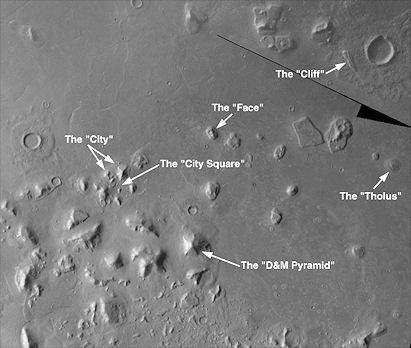
Image credit: MSSS (13)
Some years ago, there was a famous controversy about the so-called Face on Mars. An early orbiter image of an enormous mesa lying in the Cydonia Region of Mars picked out what looked like a face looking up to space from the Martian landscape. Later imagery seemed to discount this idea (13). But there was more to the Cydonia region than just the famous face. there were a number of unusual features across the landscape that invited further enquiry.
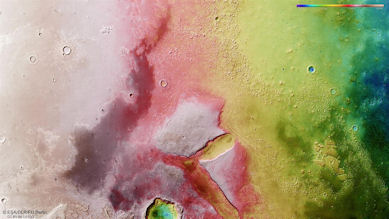
Topographical image map of part of the Cydonia region (14)
Now, this region is also home to its own water-on-Mars controversy, as at least one of the enormous mesas on this landscape appears to show geological features attributable to the flow of water. Furthermore, the impact signature of a nearby crater denotes the presence of what must have been either water or ice at the time of impact:
"The topographical view (Image 4, right) clearly shows the difference in altitude between the southern highlands (left in the image) and the northern lowlands (right). In the centre of the image there are two large mesas around 500 metres high and some 20 kilometres long, making them six times as large as the famous 1000-metre-high Table Mountain near Cape Town in South Africa. The two mountains once formed a contiguous massif but are now separated by an oval valley. The surface of the mesas differs greatly from their surroundings, indicating that the uppermost layer covering the mountains consists of a different material. In addition, on the southern side of the left-hand mesa, there is a small outflow channel.
"Slightly below the centre of the image is a 15-kilometre-wide crater surrounded by a very typical double layer of material, which was formed as a result of the impact. The inner layer of crater ejecta is covered over by the larger layer that stretches out much further. This shape is particularly interesting, as it is suspected that this special type of ejecta blanket is only caused by impacts into water- or ice-rich material. In these HRSC images, it looks as if the impact might have blasted away parts of the formerly contiguous mesa." (14)
Given that this region of Mars is a good candidate for an ancient ocean, and that there is some scientific evidence to support the presence of water and/or ice here in the past, then perhaps the Cydonia region was indeed the home of the Anunnaki colony, who set up shop during a time when this area was warmer, wetter and thus far more suitable for exploration. The raised mesa-like features on the Cydonia landscape may have been an archipelago of islands in a shallow Martian sea. That a Northern Sea once existed is no longer in doubt, and it may have lasted billions of years, scientists now think:
"“We now know Mars was wet for a much longer time than we thought before,” said [Michael] Mumma, [a senior scientist at NASA's Goddard Space Flight Center in Maryland]. Nasa’s Curiosity rover has already shown that Mars had standing water for 1.5 billion years, longer than it took for life to emerge on Earth. “Now we see that Mars must have been wet for a period even longer,” Mumma added.
"John Bridges, a planetary scientist at Leicester University, who works on Nasa’s Curiosity rover mission, said Mars was surely at least habitable in the distant past. “Ten years ago, the story of water on Mars was an occasional flood of rocky debris every 100m years that then switched off again. We now know it’s more continuous. There were long-standing bodies of water: lakes, deltas and perhaps even seas,” he said. “It seems to me that we have excellent evidence that Mars was once habitable, though whether it was ever inhabited is not clear. But there’s a chance. A life-bearing meteorite might have been ejected from Earth and could have landed in the water on Mars,” he added." (15)
On a less uninhabitable Mars, the Anunnaki would have been able to fully exploit whatever mineral resources that the Red Planet had to offer, knowing that at some point the planet would lose its short summer and return to the barren, airless dry season we witness there today.
And from Mars it's just a short hop to Ice Age Earth...
Written by Andy Lloyd, 22nd March 2015
References:
1) Malin, M. C., and K. S. Edgett "Evidence for recent groundwater seepage and surface runoff on Mars", Science, 288: 5475, 2330–2335, 30 June 2000
2) James Dickson et al. "Recent climate cycles on Mars: Stratigraphic relationships between multiple generations of gullies and the latitude dependent mantle", Icarus, 252: 83-94, 15 May 2015
3) Elizabeth Howell "Could water have carved channels on Mars half a million years ago?" 19 March 2015, with thanks to Jim
4) A. Johnsson, D. Reiss, E. Hauber, H. Hiesinger, M. Zanetti. "Evidence for very recent melt-water and debris flow activity in gullies in a young mid-latitude crater on Mars", Icarus, 235: 37, June 2014
5) Andy Lloyd "A Martian Riddle" 22 September 2014
6) Lisa Grossman "Why do we think Curiosity found an old Mars riverbed?" 28 September 2012
7) N. Mangold et al. "Sinuous gullies on Mars: Frequency, distribution, and implications for flow properties", Journal of Geophysical Research, 115: E11001, 5 November 2010,
8) James Dickson et al "Formation of Gullies on Mars by Water at High Obliquity: Quantitative Integration of Global Climate Models and Gully Distribution" 46th Lunar and Planetary Science Conference, 2015
9) Bruce Moomaw Cameron Park "The Obliquity of Mars" 30 June 2000
10) Lori Stiles "The Ancient Oceans of Mars: Gamma-Ray Evidence Suggests Ancient Mars Had Oceans" 17 November 2008
11) Ian Sample "Curiosity rover's discovery of methane ‘spikes’ fuels speculation of life on Mars" 17 December 2014
12) Touma, J. & Wisdom, J. "The Chaotic Obliquity of Mars", Science, 259 (5099): 1294–1297, 1993
13) MSSS "Cydonia: Two Years Later" 5 April 2000
14) DLR News "The Cydonia Region – was the North of Mars Once Covered by an Ocean?" 12 March 2015 with thanks to Jim. DLR is the National Aeronautics and Space Research Centre of the Federal Republic of Germany.
15) Ian Sample "Nasa finds evidence of a vast ancient ocean on Mars" 5 March 2015 with thanks to Wayne
Off-Axis Moon Causes Scientific Headache
Since we're on the subject of tilted axes, and what they might tell us about a planet's past, it would appear that our very own Moon also has some tilt issues. A careful examination of the distribution of water ice at the lunar poles has shown that the Moon experienced a pole-shift at some point in its past.
"Although scientists had noticed before that the water was not centered at the current poles, no one had noticed this precise off-axis, antipodal relationship. “Everyone is basically kicking themselves and saying, ‘Why didn’t I notice this?’ ” [Matthew] Siegler [a planetary scientist at Dallas's Planetary Science Institute] says." (1)
The reason the scientists initially missed this, of course, is that they didn't expect to see it. Just like NASA missed water on the Moon for decades, despite the evidence under their noses. India's ISRO Chandrayaan-1 lunar orbiter then detected water on the Moon in 2009, overturning the apple cart.
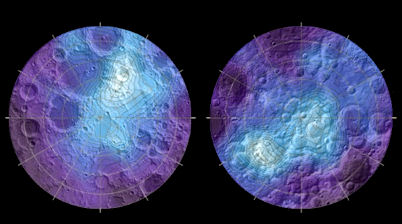
Image Credit: Richard Miller, University of Alabama
The Moon is tidally locked in its orbit around the Earth, such that it rotates on an axis perpendicular to its orbital plane around us. A shift in its axis would presumably create a very different dynamic relationship between the Moon and Earth. However, in terms of survival of ice on the lunar surface, its the Moon's axial relationship with the plane of the ecliptic that really counts:
"Solar radiation would normally strip any free water or water ice from the lunar surface, splitting it into its constituent elements, hydrogen and oxygen, which then escape to space. However, because of the only very slight axial tilt of the Moon's spin axis to the ecliptic plane (1.5 °), some deep craters near the poles never receive any sunlight, and are permanently shadowed. The temperature in these regions never rises above about 100 K (about −170 ° Celsius), and any water that eventually ended up in these craters could remain frozen and stable for extremely long periods of time — perhaps billions of years, depending on the stability of the orientation of the Moon's axis." (2)
Which leads us to the main problem here: If the off-centre ice formed early on, and the axis shift occurred, say, billions of years ago, then how have the off-centre deposits of ice survived, even if they're holed up in deep lunar craters on the lunar surface? As the Moon spins on its axis, these craters should be more readily exposed to the action of the Sun's glaring heat and the relentless solar wind than ice in polar craters.
It's perfectly possible that the early Moon had abundant supplies of water (3). The Earth and Moon are intimately related, either forming as a double planet, or the Moon forming as a result of a massive collision between the early primordial Earth and a Mars-sized body. Over time, additional water ice could have been added to the Moon by comet impacts (4) - particularly during the late, heavy bombardment 3.9 billion years ago (5) - or by chemical action on the lunar surface (6). But, there should still have been an erosion of that water ice if exposed to the action of the Sun over time. There should be a cyclical process of deposition and then removal over time through sublimation into space. Which presumably implies that extant non-polar ice as either relatively recently deposited, or is hidden from the Sun's eroding glare. Either of these answers still begs the question - why this particular distribution of remnant non-polar ice?
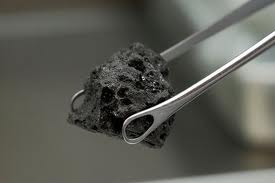
So what's going on here? Does this not imply that whatever happened to the Moon's axis, happened relatively recently? Some people believe that this is exactly what happened only a few years ago (7), as a result of a Planet X perihelion passage (which somehow the rest of us seemed to miss at the time). While I don't think this to be true, the Moon does appear to have shifted on its axis within a reasonable time-frame:
"Oded Aharonson, a planetary scientist at the Weizmann Institute of Science in Rehovot, Israel... isn’t sure the ice could have persisted for so long. At other times in its ancient past, the moon’s poles are thought to have wandered far enough to bring polar regions near the sun-drenched equator. Moreover, ice could be destroyed by large asteroid impacts. For the ice to survive, the 5.5° tilting event would need to occur after those cataclysms, he says. “It’s really critical not to do this [tilting] too early in lunar history,” he says. (1)
This point implies that the Moon's obliquity has been fairly dynamic, like that of Mars. But we could easily throw the baby out with the bathwater here:
"The Moon's obliquity is about 6.5 degrees, but is locked to the orbital inclination to the ecliptic of 5 degrees, so that the Sun can rise no more than 1.5 degrees above the horizon at the lunar poles. It is important that this locking, called a Cassini state, stay for long periods in order to allow water ice and other volatiles to collect in shadowed crater floors near the lunar poles. If the Moon's obliquity had ever been unlocked in the past, these volatiles would have quickly escaped into space." (8)
The high obliquity period hinted at by Oded Aharonson occurred when the Moon was about half the distance from Earth than it is now, during a period known as the Cassini State Transition (9). But it is thought that this period occurred some 3-4 billion years ago (9), which does not move us on too well given the current problem under debate.
So how stable is the orientation of the Moon's axis more recently - say in a timeframe of millions rather than billions of years? If we're to understand why the non-polar ice is still hanging around following an pole-shift, then that timeframe is surely more relevant. If the Moon's obliquity is not really all that stable after all, then what events in its past caused the decline in its axial stability? Do these events point to a different origin for the Moon than the collision theory? If the Earth/Moon system is essentially a double planet, born together from the same material, then whatever happened to the Moon way back when to destabilise it could teach us a great deal about the early catastrophic history of our solar system.
For those interested in Zecharia Sitchin's theories, the Moon (in the form of 'Kingu') was already orbiting the early Earth (Tiamat) at the time of the Celestial Battle (9). Within that context, it seems quite likely to me that the long-term instability of the Moon's axial orientation resulted from the incident with Nibiru/Marduk, the Dark Star, 3.9 billion years ago. The Earth/Moon double system, with Earth heavily wounded, migrated inwards. The Moon clung on, but its long-term obliquity was destabilised as a result.
There's another possibility, following a similar line of attack. Sitchin considered it likely that some of the returns of Nibiru resulted in catastrophic events on Earth. The Biblical Flood is an example, which he considered to have been a cataclysmic jolting of the Antarctic ice cap at the end of the last Ice Age. Perhaps the gravitational effect of Planet X which led to this event also disrupted the Moon's obliquity, leading to the shift in the position of its poles as a result?
Written by Andy Lloyd, 24th March 2015
References:
1) Eric Hand "Lopsided ice on the moon points to past shift in poles" 19 March 2015, with thanks to Lee
2) "Lunar Water"
3) H. Hui, A.H. Peslier, Y. Zhang, C.R. Neal "Water in lunar anorthosites and evidence for a wet early Moon" Nat. Geosci., 6: 177–180, 2013
4) Jeff Hecht "Soggy space rocks brought water to young moon" 11 December 2014
5) Uffe Graae Jørgensen et al. "The Earth-Moon system during the Late Heavy Bombardment period" 23 July 2009
6) Paul Marks "Moon water blew in on solar wind" 7 October 2014
7) Gerald Zwaan "Earth Changes and the Pole Shift" 18th August 2011 (article no longer available online) Author blog here:
8) Pete Jackson " Does the Earth help stabilize changes in the Moon's Obliquity as well?" 20 August 2011
physics.stackexchange.com article
9) Matthew A. Siegler et al "Effects of orbital evolution on lunar ice stability" Journal of Geophysical Research, 116: E03010, 31 March 2011
10) Zecharia Sitchin "The Twelfth Planet" Avon, 1976
Enceladus's Boiler Room
It was something of a pleasant surprise when the scientists working on the Cassini probe's voyage to the Saturn system presented images of water gushing out into space from one of its moons. We're not talking about the massive moon Titan, but rather one of its more diminutive siblings - Enceladus.
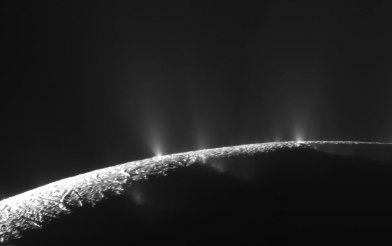
Spectacular geysers of water blast out of Enceladus into space
On the face of it, Enceladus is not a great candidate for liquid water. Saturn is, after all, a heck of a long way away from the Sun, and it's pretty cold out there. So, where Jupiter's Galilean moons still get a fair bit of sunshine, Enceladus is very much a poor cousin in this regard. Yet, the same processes that warm the Galilean moons, making them potentially great candidates for life in warm sub-surface oceans, appear to also be at work on Enceladus. Additionally, that warm water is firing out of the small Saturnian moon, under a fair bit of pressure.
“This moon has all the ingredients – water, heat, and minerals – to support habitability in the outer Solar System, confirming the astrobiological potential of Enceladus,” adds Nicolas Altobelli, ESA’s Cassini project scientist. Enceladus may even represent a very common habitat in the Galaxy: icy moons around giant gas planets, located well beyond the ‘habitable zone’ of a star, but still able to maintain liquid water below their icy surface.” (1)
Recent scientific work has sought to clarify how this might be happening (2,3).
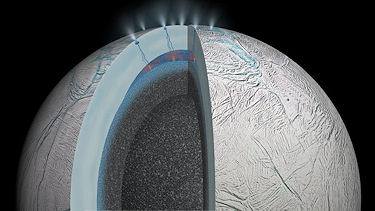
Image Credit: ESA
The water emanating from the moon contains particles which have been duly analysed by Cassini, and which provide a clues as to the dynamic mechanisms at work within this busy little world:
"...these silicon-rich grains originate on the seafloor of Enceladus, where hydrothermal processes are at work. On the seafloor, hot water at a temperature of at least 90 degrees Celsius dissolves minerals from the moon’s rocky interior. The origin of this energy is not well understood, but likely includes a combination of tidal heating as Enceladus orbits Saturn, radioactive decay in the core and chemical reactions." (1)
Although the explanation hints at some independent, internal warming processes (both radioactive and chemical), the predominant effect at work here is the tidal heating. This is a central point to the Dark Star Theory. For a planet to be warm enough to sustain life out beyond Neptune (i.e. the fabled Nibiru/Planet X), then it requires partnership with a massive body nearby to provide the gravitational and magnetic fields sufficient to warm its interior. Enceladus shows just how incredibly strong this effect can be, given its distance from the Sun, and its orbit around a smaller gas giant than Jupiter, in this case the beautiful Saturn. So just imagine the potential for a warm home-world orbiting around a sub-brown dwarf several times the mass of Jupiter!
Written by Andy Lloyd, 14th March 2015
References:
1) ESA "Hot Water Activity on Icy Moon's Seafloor" 11 March 2015
2) Hsiang-Wen Hsu et al "Ongoing hydrothermal activities within Enceladus" Nature, 519L 207–210, 12 March 2015
3) Alexis Bouquet et al "Possible evidence for a methane source in Enceladus' ocean", Geophysical Research Letters, 11 March 2015
onlinelibrary.wiley.com abstract
Blood Red Planet Behind the Moon?
Correspondence received on 8th March 2015:
Dear Andy,This picture was taken on 10/08/14 during the blood moon, from Dover, PA by someone I went to high school with. I’ve been learning about Planet X / Nibiru and came across your website
andylloyd.org/darkstarblog23.htm, and then your blog. Since you are knowledgeable about this subject, and this picture is perplexing, I wondered if you might be able to identify what the red planet in the background is? I searched and found some other photos that showed Uranus as a small dot to the lower left of the moon that night, but this photo seems to capture a planet there that does not make sense.

Image Credit: Cory's old school friend
Just wanted to reach out to someone more familiar with the subject, as you seem to be, and thought you might like to see it.
Thanks in advance
.Cory
~~ * ~~
Hi Cory,
Thanks for sending this photo through. My gut feeling is that the red planet is a lens flare from the glare of the Moon. The Moon appears to be almost full (effectively in opposition to the Sun), but the 'planet' is partly occluded, giving the impression that it would be in a different position with respect to the Sun than indicated here. In other words, if it was indeed a planet then it, too, should be almost full, like the Moon, rather than being in 1/4 shadow. Did the person who took the ph
oto actually see this red object at the time, or did it appear on the photo unexpectedly?Many thanks,
Andy
~~ * ~~
Correspondence received on 8th March 2015:
She took the picture of the moon with her cell phone that night, not noticing the red planet image until later when she posted it, and at that point questioned why it was there. Thank you for explaining the lens flare / shadow effect, which makes sense. Sure is an odd image, nonetheless. Appreciate you taking a look at it, Andy!
Best Regards,
Cory
The Germanwings Airbus Crash and the LHC
26/3/15: We now have a pretty good idea about what
tragically happened to this flight, but I'm keeping this
item on the blog because I think it does raise some
interesting concerns about what happened with the LHC
back in 2008, and also addresses some of the wider
issues about the LHC's work as it upgrades itself to
bigger, more energetic projects:
~~ * ~~
Another tragic, and mysterious, aircrash took place on
Tuesday 24th March 2005 in the French Alps.
Germanwings 4U 9525 flight en route from Barcelona to
Dusseldorf descended unexpectedly, and apparently
without discussion with air traffic control, over an
approximately 10 minute period before striking the side
of a snow-covered mountain in the Maritime
Alps to the north of Nice (1).
It has been suggested that there may
have been a connection between this tragic event, which
saw the loss of 150 lives, and the re-starting this week
of the Large Hadron Collider (LHC) on the French-Swiss
border somewhat to the north of this position (2,3).
Is this plausible? To the right are some maps
of the location, from FlightRadar24,
which tracks air traffic around the world. Looking at the trajectory
of the plane - whilst considering the
10 minutes of unexpected descent
before contact was lost with the aircraft -
the drama preceding the crash presumably began somewhere
over the Cote d'Azur and continued as the plane moved to
the Northeast into the Alps. The LHC is quite a bit to
the north of this position, up on the Franco-Swiss
border near Geneva. If
the LHC was responsible by somehow
firing off a burst of high-energy particles in a random
direction as it tried to carefully align the beams within
its 17-mile underground
circuit, then it would have been one freaky coincidence
for a plane over a
hundred miles away to have been
hit by it!
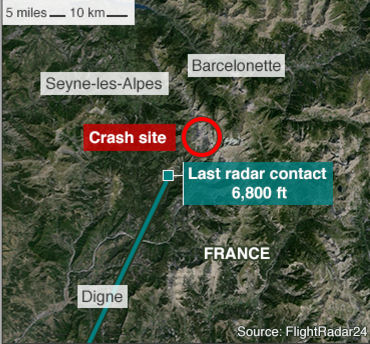
However, check this
point out, from an article about the preparations for experimental work undertaken on the LHC back in 2010:"Between now and 30 March, the LHC's team will be working to commission the beam control systems and the systems that protect the machine's detectors, or experiments, from stray particles." (4)
So, do they mean stray particles coming in (like cosmic rays), or particles getting out? Or do they simply mean the beams crashing through delicate parts of the structure, causing internal damage? It's not clear. What is clear, however, is that this time around the particles will have a lot more energy:
"This week, after several years of upgrading the LHC's magnets (which speed up and control the flow of particles) and data sensors, it'll begin "run two": a new series of experiments that will involve crashing particles together with nearly twice as much energy as before." (5)
Look, I know very little about particle physics. Are these beams actually dangerous, in a James Bond Villain kind of way? Here's Wikipedia's discussion of the operational challenges of firing these particle beams around the LHC:
"The size of the LHC constitutes an exceptional engineering challenge with unique operational issues on account of the amount of energy stored in the magnets and the beams. While operating, the total energy stored in the magnets is 10 GJ (2,400 kilograms of TNT) and the total energy carried by the two beams reaches 724 MJ (173 kilograms of TNT).
"Loss of only one ten-millionth part of the beam is sufficient to quench a superconducting magnet, while the beam dump must absorb 362 MJ (87 kilograms of TNT) for each of the two beams. These energies are carried by very little matter: under nominal operating conditions the beam pipes contain 1.0×10−9 gram of hydrogen, which, in standard conditions for temperature and pressure, would fill the volume of one grain of fine sand." (6)
Engineers at Cern are well aware of the risks, not least to the internal workings of the collider itself:
"Mike Lamont, head of accelerator operations at Cern, said that over the next few days, teams would check that safety devices were in place to make sure the high energy beams could not damage the LHC. "This beam has got a lot of destructive power," he said. "We'll spend a lot of time setting up our protective devices to make sure we can handle these beams safely."" (6)
Indeed. There was a big problem in 2008 at the LHC when an 'electrical fault' was thought to have led to the leaking of a huge quantity of liquid helium, accompanied by an explosion. Following an internal investigation, there doesn't seem to be any reason to think that a stray high-energy beam caused the accident, although the use of the word 'believed' leaves the door open just a little to that possibility:
"Problems occurred on 19 September 2008 during powering tests of the main dipole circuit, when an electrical fault in the bus between magnets caused a rupture and a leak of six tonnes of liquid helium. The operation was delayed for several months. It is currently believed that a faulty electrical connection between two magnets caused an arc, which compromised the liquid-helium containment. Once the cooling layer was broken, the helium flooded the surrounding vacuum layer with sufficient force to break 10-ton magnets from their mountings. The explosion also contaminated the proton tubes with soot. This accident was thoroughly discussed in a 22 February 2010 Superconductor Science and Technology article by CERN physicist Lucio Rossi." (7)
So, if not a direct threat through accidental release of a
n actual particle beam weapon across the French Alps, then could there have been some kind of 'Lost' like event through an bizarre, reality-bending experiment taking place? It doesn't look like a new experiment is due to take place until 30th March 2015, and even that may have been delayed (8). But even if an experiment had already taken place, surely planes in the Geneva area would have been similarly affected?As bizarre as the circumstances around this accident are, the LHC is innocent of all charges. I'm sure we'll find out more in the coming days and weeks *.
Written by Andy Lloyd, 2
5th March 2015* And indeed we did; the co-pilot is alleged to have been responsible for this disaster on the basis of data extracted from the recovered black-box flight-deck recorder, and other evidence gathered by investigators.
References:
1)
BBC News "Alps plane crash: What we know" 25 March 20152) Correspondence from Bruce, 25 March 2015
3) Stefan Stanford "Did CERN Bring Down German Airbus A320? Plane Crash 'Conspiracy Theories' Emerge Include The 'Hudson ISIS Time River Theory'" 24 March 2015
4) Paul Rincon "Large Hadron Collider to start hunt for 'God particle'" 23 March 2010
5) Joseph Stromberg "The Large Hadron Collider is starting back up. Here's what scientists hope to find" 23 March 2015, with thanks to Bruce
6) Ian Sample "Cern restarts mission to explain everything" 6 April 2015, The Guardian, p3
7) Large Hadron Collider
7) AP "Small metal piece delays restart of CERN's Large Hadron Collider" 24 March 2015
ctvnews.ca article
You
can keep informed of updates
by following me on Twitter:
Or like my Facebook Page:
https://www.facebook.com/darkstarandylloyd

![]()